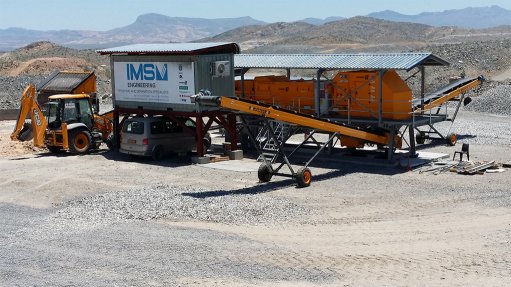
Company Announcement - A leading southern African diamond mine famous for its large, top quality diamonds, reports success with the two IMS Engineering Steinert X-Ray transmission sorters that are being used in the Final Recovery Plant of the mine. These are the first XRT Sorters to be used in Final Recovery of any diamond mine.
IMS, who has a JV with Steinert for the supply and development of sensor sorting technology into the mining, industrial minerals and recycling industries, says that Steinert XRT technology has developed rapidly over the past year or so. “The development of unique sorting algorithms that allow for extremely high accuracy in the detection and ejection of diamonds has created significant opportunities for new and cost-effective ways to separate minerals from waste,” says Paul Bracher, Managing Director.
In this southern African project, extensive test work was carried out to show the client that the XRT system could detect diamonds as predicted by IMS. “It was as a result of this test work that we could provide our process guarantees. We tested both simulants and diamonds provided by the client. The goal was to achieve 100% recovery during test work and we are proud to report that this was in fact achieved,” says Bracher.
He adds that during the test work, separation algorithms were further developed for detecting and ejecting diamonds and hardware optimizations were carried out at the same time.
For this particular application the equipment had to be re-designed to fit the client’s footprint requirements. During this process, IMS and Steinert integrated the latest developments in the detection equipment as well as improvements in the algorithms developed during the test work. “The result was that we were able to customize the sorter to fit the required footprint, while retaining the maintainability through using standard components” says Bracher. “We have improved all areas of performance including detection and ejection into a secure area, all while obtaining the lowest possible yield to increase the diamond by weight ejected.”
After being awarded the contract IMS project-managed the building of the machine and carried out quality management tests which culminated in factory acceptance and sign-off. The machines were then delivered to site where IMS supervised installation and commissioning. During the commissioning phase a 52-carat GNT type 2, 75% unbroken diamond was recovered by the coarse sorter. “While the finding of large Diamonds is always newsworthy, the detection of large stones is easy for the technology. Of more technological significance was the detection of 2-carat diamond was recovered in tailing material during pre-commissioning tests”.
A mine spokesman says that he looks forward to continue reaping the benefits of the XRT technology at this critical stage of the sorting process. “We are pleased to be the pioneers for this technology in the diamond mining industry. The results of the extensive pilot work that we did were indeed most encouraging and this has now been verified by our significant 50-carat recovery,” he said. IMS has shown that XRT is the cutting edge in diamond recovery technology with its main advantage being that it detects different x-ray absorption levels of different material types. The resulting x-ray images relate to the atomic make-up of each particle going through the XRT detection zone of the machine. Therefore, a diamond, which consists of carbon atoms, appears as a light-grey x-ray image when compared to denser waste rock and, because this is sorting on an atomic level, all diamonds, no matter what their physical characteristics, can be detected with the Steinert XRT technology.
How it Works
From a practical perspective, the diamond ore is presented to the sorter via a vibrating feeder which feeds it onto a belt as a single particle layer. The ore travels on the sorter belt and the individual particles are scanned as they pass through the x-ray beam. The particles attenuate the transmitted x-rays which are detected and recorded. The signals are processed through an advanced algorithm that enables the program to differentiate between the less-dense carbon of diamonds and the denser minerals of kimberlite and other waste rock.